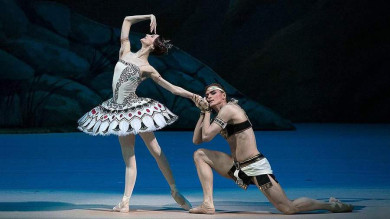Staged in 1862, The Pharaoh's Daughter was one of the largest and most luxurious ballets of its time.
Marius Petipa´s choreographic text was restored using Nikolai Sergeyev´s notation from the Harvard Theatre Collection.
The settings and costumes were created based on sketches of the original production of the Imperial Ballet at the Imperial Bolshoi (Stone) Theatre on January 18 (30), 1862 (art design by Andreas Roller, set design by Hermann Wagner, costumes by Kelver and Stolyarov) and sketches of the production at the Mariinsky theatre presented on November 10 (22), 1885 (art design by Orest Allegri, set design by Pyotr Lambin, costumes by Grigoriev and Evgeny Ponomarev).
A four-act action with a huge number of characters, and therefore costumes, with eight changes of scenery, inventive stage effects and a variety of props, including two life-sized camels, a lion, a swarm of bees and other accessories of an exotic entourage. The choreographer Marius Petipa did not stint on a variety of dances, since the libretto, compiled together with the French playwright Saint-Georges, gave room for the performance of many soloists. The story of a dream about a revived mummy and her love adventures at the foot of the pyramids and under the waters of the Nile, like most ballets of that time, hardly pretended to catharsis among the audience, but certainly surprised and delighted them with the virtuosity of the dances and the eloquence of pantomime. The performance lasted on the stage for sixty-six years, regularly collecting full houses! The success of "The Pharaoh's Daughter" brought Marius Petipa not only recognition, but also the post of ballet master of the imperial theaters, and for many artists this performance has become one of the most beloved and expensive in the repertoire. At the beginning of the 20th century, the choreographic text was written down, and today the preserved sheets with icons describing movements and verbal comments of eyewitnesses are the main source of knowledge about the dances of the legendary ballet of the past. The pre-revolutionary production sketches became the key to the luxury of the new scenography.
Synopsis
Prologue
Scene 1. A Desert near the Pyramids of Gizeh
A caravan of merchants stops to rest near the Pyramid. Englishmen, a young traveler Lord Wilson and his servant John Bull are invited to join them. Bayadères entertain them with dancing. Suddenly, a sandstorm makes everyone seek shelter in the pyramid.
Scene 2. Inside the Pyramid
The old watchman explains that they find themselves inside the resting place of the Pharaohs' daughter Aspicсia. Smoking opium, Lord Wilson falls into a delirious sleep. A magical transformation takes place, the mummies come to life. Reassured to find herself as beautiful as she ever was, Aspicсia approaches the sleeping Lord Wilson. She makes him follow her into the past.
Act I
Scene 3. In the Forest
The Pharaoh’s daughter and her retinue are lion hunting. Taking a break, Aspiccia’s confidante Ramzé starts playing lute causing all others to fall asleep. Aspiccia is frightened by a monkey, then a bee stings her. A lion pursued by huntresses threatens her, but the young Egyptian Ta-Hor bravely shoots the beast. Aspiccia thanks him.
The Pharaoh enters with his retinue. He orders Ta-Hor and Pasifonte to be captured, but Aspiccia explains what has happened. The Pharaoh invites them to his palace.
Act II
Scene 4. The Pharaoh's Palace in Thebes
Aspiccia presents Ta-Hor with rich gifts in gratitude for saving her life, but he declines them.
The Pharaoh greets his guest, the Nubian King. Struck by Aspiccia’s beauty, the Nubian King asks for her hand. Ta-Hor reaches out for his dagger to challenge his opponent, but Aspiccia’s pleading gaze calms his anger. Aspiccia and Ta-Hor decide to run away. Ramzé helps them to succeed giving them a secret door key. A slave informs the Pharaoh about the escape of the lovers. The Pharaoh threatens Ramzé with his wrath, but true to her mistress, she does not say a word. The Nubian King pursues the fugitives, while the Pharaoh is in anger and sorrow.
Act III
Scene 5. The Fisherman's Hut
A fisherman’s couple is celebrating their recent wedding. Guised in peasant clothes, Aspiccia, Ta-Hor and Pasifonte knock, asking for shelter. Aspiccia tells the company they were caught in a storm while fishing and barely made it back to shore. At nightfall, the fishermen set off to fish. Ta-Hor offers them his help. Aspiccia stays alone and is startled by the Nubian King. He reminds her that she is his fiancée. Aspiccia orders him to leave, telling that she is in love with another man. The Nubian King is deeply offended. Aspiccia finding no escape throws herself into the Nile. Ta-Hor and Pasifonte return, but instead of the princess, they find the Nubian King, who demands that they be captured.
Scene 6. In the Nile
Aspiccia’s body descends to the bottom of the river. The Nile greets her and arranges a celebration in her honor, to which rivers are invited from different countries. Aspiccia asks to see her loved ones again. She perceives her father in deep sadness, and her beloved in chains. Struck by this, she begs to be brought back to the surface. The Nile grants her wish.
Act IV
Scene 7. The Pharaoh's Palace in Thebes
The Pharaoh doesn't understand what has happened to his daughter. To demonstrate what punishment awaits the captive Ta-Hor, Pasifonte and Ramzeé, he orders a slave to be killed by a venomous snake.
Just in time Aspiccia and the fishermen enter the palace. She tells her father about her adventures. Pleading for justice, she accuses the Nubian King for mistreating her. The Pharaoh liberates the innocent, blesses his daughter's union with Ta-Hor, and orders the Nubian King to leave. The feast begins.
Epilogue
Aspiccia calls for Lord Wilson. Or is it still a dream?
 Mariinsky Theatre:
Mariinsky Theatre:  Mariinsky-2 (New Theatre):
Mariinsky-2 (New Theatre):  Mariinsky Concert Hall:
Mariinsky Concert Hall: 

